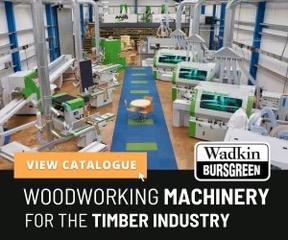
By Dean Elkins, of Yaskawa America Inc – Motoman Robotics Division
From greater precision and consistency to increased efficiency and quality, robots provide considerable benefits to the labour-intensive woodworking industry, helping to improve the fit and finish of goods while optimising production operations.
Moreover, robust yet easy-to-program robots with multi-function end-of-arm tooling (EOAT) are readily deployed and redeployed on demand, adding greater flexibility on the shopfloor to meet increased customer demands for various shapes and sizes.
Needless to say, these advantages have prompted more manufacturers in recent months to take a second look at robotic automation as a viable option to smooth production inefficiencies caused by the Covid-19 pandemic. As a result, decisionmakers in the woodworking industry are finding that some of the most beneficial uses for robotic automation in the woodworking industry are as follows …

Machine tending and material handling
Popular for optimising safety and improving cycle time, extremely fast, flexible-use robots (ranging from 7-300kg payload) are well suited for loading and unloading wood to CNC machines and other equipment for processing. Application examples include loading of band saws, dowel insertion machines, drilling machines, edgebanders, milling machines, panel saws and T-nut insertion machines.
Widely used for these applications, intelligent 2D or 3D machine vision can expertly locate parts so that the robot can pick them up precisely and consistently. Prime examples of this include finding a board on a stack, or locating a specific board on a conveyor prior to loading it into a machine.

Sanding
When preparing a surface for a specific finish, the use of application-specific robots for these dull and dirty tasks can seamlessly and efficiently guide material removal media over a surface. This creates consistently smooth edges and surfaces. And, depending on the product, robots can be programmed to sand with different contact pressures or removal rates, with the help of intelligent sensors and intuitive software programs.
Painting and gluing
Popular for spraying glue to adhere layers of laminates together, high-performance dispensing robots can increase consistency and throughput, while dramatically decreasing wasted material and lowering operating costs. The same goes for painting robots, which also enhance finish quality. The use of robotic vision is also very helpful with these applications.
Material transfer and palletising
Four-, five- and six-axis robots designed for picking, packing and palletising are ideal for the handling and transfer of small-to-large workpieces in a reliable way. From packaging operations for ready-to-assemble furniture to palletising operations for heavy payload cabinets or furniture, these robots are perfect for completing the repetitive tasks.
Highly flexible software packages, such as PalletSolver, can also enable offline pallet pattern generation for virtually any mix of SKUs, optimising the execution of pattern files and robot operation for fast deployment of even the most complex palletising workcells.
Best suited options
No matter the situation, there most likely is a robot that can help optimise your production operations. In spaces where robots need to work with or in close proximity to humans, collaborative robots, like the HC10DT, are being deployed in unique ways (based on a thorough risk assessment).
Moreover, the new HC20XP collaborative robot, with an easy-to-clean surface and hand-guided teaching, is fulfilling a wide range of tasks, including the reach of full, 80in-tall pallets, without an elevator.
Overall, the use of robotic automation in the woodworking industry increases product quality and throughput, while saving time and money. It also lightens the physical burden for manual workers, freeing them to be redeployed to other value-added tasks within the company, mitigating risks while building valuable competitive edge.
Dean Elkins is segment leader - material handling at Yaskawa America Inc, Motoman Robotics Division








